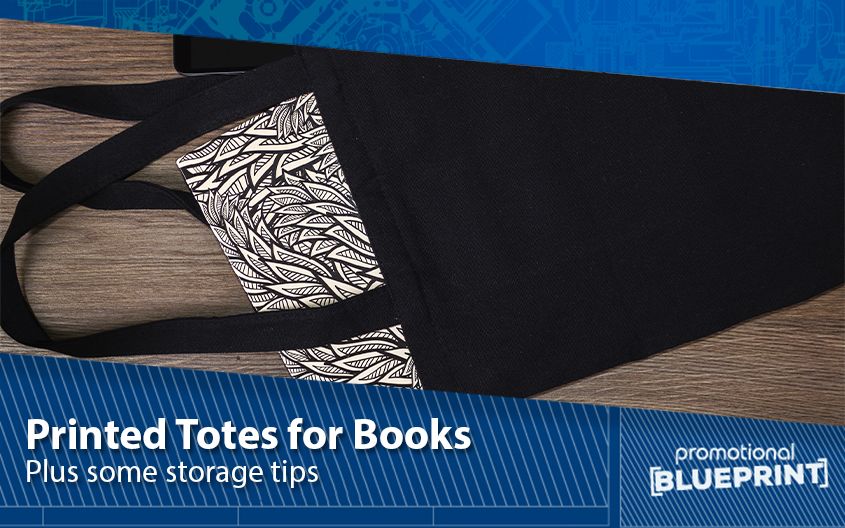
It seems like an antiquated notion to the modern reader: “Hey, want to go to the library?” Libraries still exist, of course, and even in 2022, there are lots of eager readers out there that are card-carrying members. But in the age of PDFs, eBooks, and audiobooks, should we even join a local library?
Obviously, the answer is yes. After all, most of the other options cost a lot of money. With a library membership, all we have to do is pay our monthly fee and we get access to thousands of books just waiting to be read. Naturally, as members, we have to take care of those books, since they are the property of the library that provides them. In this article, we will go over the best ways that modern readers can carry and store their library books in order to avoid damaging them.
Carrying the Books: Durable Tote Bags
Avid readers can take out as many as ten different books from the library. Carrying such a load is not easy, especially if we live some distance away from the building itself. So, we will need a method of transporting those books, and tote bags seem to be the best option.
Nowadays, tote bags can be huge; big enough for a decent grocery shopping trip at the local mall. In addition, the materials used to create tote bags are incredibly tough and can handle huge loads. To put it simply, if we want to carry several pounds worth of reading material, a cotton tote or a canvas bag is the most efficient option. We can even go a step further and buy a drawstring tote such as GoPromotional‘s Windermere Recycled Drawstring Tote Bag.
Related content:
Take Note of These Things Before Purchasing A Canvas Tote Bag
Tips on Storing Library Books
Checking for Damage
There are two instances when we will check the books we’ve borrowed for damage:
- At the library
- At home, after a period of time.
When we take out a book that we want to read, the first thing we will want to do is check for any potential damage it has. That way, we can immediately report it to the librarian so that they can take the damage into account once we’ve returned the book to them.
Once we have the book at home for a certain amount of time, we will want to check for damages regularly. We’ll be looking for any scratches, scrapes, tears, stains, and loose threads. Furthermore, the books will have to be somewhere without mould or mildew, as they can damage paper and give the book an unpleasant smell.
Wrapping the Books
When storing the books, we will want to wrap them into something thin so that no dust or stains get to them. Paper towels will usually do the trick, but we can go with any other material. Some ideas include:
- Food plastic wrap
- Aluminium foil
- Wrapping paper
- Thin cloth handkerchiefs.
Storage Containers
If we pay a visit to a plastic goods store, we will probably find one or more storage containers perfect for storing books. Some of them are actually quite literally made for book storage, especially the long, narrow ones that enable us to place books vertically (more on that later).
Naturally, the containers don’t need to be plastic. We can get a few durable tote bags or jute bags like the Willow Natural Jute Shoppers, hand them off a hook, and place the books in them. That way, the books will be far away from any potential liquid or dust, plus they will stand upright. Tiny racks or stands will also do the job well, as long as we align the books the right way.
Storing Books Vertically
Placing the books next to each other vertically on the shelves is the best way to prevent anything from happening to them. Plus, it is the most aesthetically pleasing way of stacking books.
Of course, just placing them on the shelf isn’t enough. We also need to make sure that no part of the book is sticking out. After all, the damage can come from any direction, and if even a small part of the book is exposed like that, anything can happen to it.
Spillage Protection
As tempting as it may be, we have to keep all liquids away from our printed material. That means no coffee, tea, juice, alcohol, or even nail polish near the books we took from the library. All it takes is a single spill and already we’re in the line, ready to pay the fine for damaging a book.
Additional Tips
To cap this list off, here are a few other tips and tricks on handling library books that we think are important:
- Absolutely no rubber bands or paperclips; if we use them on a library book, they will most definitely leave an indentation
- By no means are we to write anything onto the pages of the books, even if we use a pencil
- Photocopying books that have loose or torn pages is a big no-no
- Before reading, we need to make sure our hands are clean and dry
Library Books (and How to Take Care of Them)
It might seem like a hassle to go through all of that trouble just to read a book from the library. But it’s a small price to pay for reading an excellent title at a fraction of its original cost. If you can, join your local library and discover the joys of endless reading with a wealth of material at your fingertips.
You may also like:
What You Should Know About Printed Non-Woven Bags
Looking for something different? Browse our full range of promotional bags which includes backpacks, non-woven bags, and travel bags. You may also check out our new products if you’re in search for new corporate gift ideas. If for any reason you still can’t find what you are looking for, then simply give us a call on 0800 0148 970 or simply email us today.






